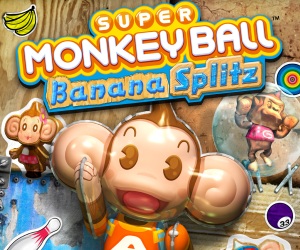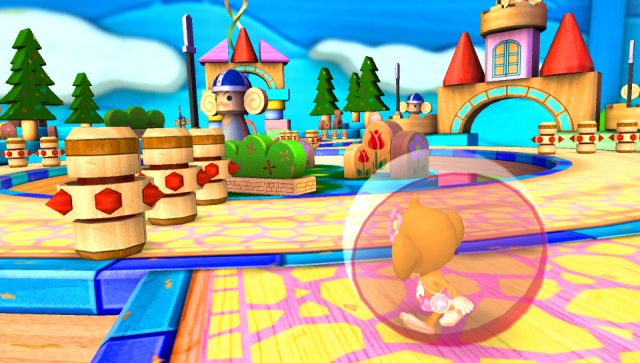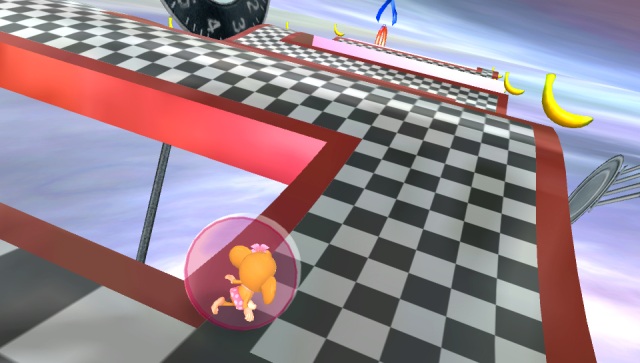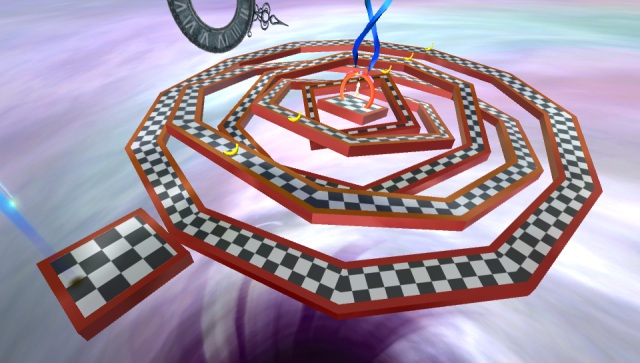Super Monkey Ball: Banana Splitz Review
 Game: Super Monkey Ball: Banana Splitz
Game: Super Monkey Ball: Banana Splitz
Developer: SEGA
Publisher: SEGA
Available On: PlayStation Vita Only
It is a little known fact that Super Monkey Ball began life as an arcade cabinet. I don’t ever remember actually seeing one in the wild, but am told it had a control stick shaped like a banana. Of course, the series is more famous for being one of the launch titles for the Nintendo Gamecube, where it was a huge success and one of the best launch titles in recent memory. With simple, Marble Madness-esque gameplay that required the use of just the analogue stick to guide simian AiAi around the course toward the goal.
The trouble with Monkey Ball is that after the fine first effort, which was a classic slice of colourful SEGA arcade action, the series gradually descended into mediocrity with unnecessary additions like storylines, sub-par minigames and even an action-adventure spin-off being produced. Like the blue blur that became their de facto mascot, SEGA were guilty on a number of occasions of ignoring what made the original game so fun; the actual physics based courses, an excellently woozy sense of speed and momentum and a lean package devoid of any rubbish add-ons. Can this new Vita-exclusive offering provide us with some of the winsome ape-related thrills of its distant forebear, or is it another instalment that makes us want to fling excrement from our cage?

The simple answer is that when it focuses on what made the original game so brilliant, then this is quite often a barrel of monkey laughs, but there are some flaws. Banana Splitz does some of what it sets out to do extremely well. Graphically the game looks lovely on the OLED screen; a bright, colourful treat that evokes memories of a time when SEGA regularly produced lovely looking arcade games almost effortlessly.
The core gameplay comes from the Story Mode, which doesn’t actually have any story running through it, but serves up over 100 well-designed, increasingly more difficult levels set over five distinctly different worlds. Using the left analogue stick, or well-implemented motion sensor controls, the main game controls well for the most part, although I found that some of the more tricky levels were slightly easier using the stick to control your monkey ball rather than the super-sensitive balancing act that is the motion sensor, particularly when you often have to tilt the console forward, meaning that unless you have a neck like Reed Richards you are unable to see the screen properly.

The levels start out simple enough, with easy-to-get banana collectibles and straightforward routes to the goal, yet soon become mind-bendingly difficult with all manner of obstacles and treacherous areas to navigate. The game mechanic is as compulsive as it ever was, do you attempt to grab all of those bananas and risk falling off the edge or running out of time, or do you take the quick option and aim straight for the goal? Whichever way you play there are Trophy rewards, such as one for collecting all of the in-game fruits, and another for successfully conquering the levels using the motion controls. My main gripe with the excellent main game is that the levels are served up to you in groups of ten with no way of replaying an individual level or saving your game midway through a ten-level slog. It is a crazy structure for a game that has definite score-attack potential, and one in which there is that aforementioned Trophy for collecting all of the bananas.
Like Monkey Ball of days past, there are several mini games on offer, which provide a distraction from the often nails-hard main levels. Some of these, like the Pilotwings-lite returning fave Monkey Target and Monkey Bowling, which requires that you hold the console vertically and flick AiAi and co towards the pins, are excellent fun. Yet for each worthwhile party game there seems to be something poor like Monkey Rodeo, which seems to involve randomly hammering the rear touchpad with your fingers for approximately zero gain.

There are some nice online bits and bobs to the package, like an ad-hoc and wi-fi multiplayer and the ability to upload your replays and compete with other players in your area (or indeed around the globe) using the GPS functionality to become King of the Monkey Mountain. There is also a level creation mode, which sounds tantalisingly excellent, the premise being that you take a photograph and then get to create a stage based around the shot you have just taken in an Augmented Reality fun-fest, but this proves to be extremely disappointing. You take a picture, and are then rather oddly asked to shake the console repeatedly as it works its magic. What you then get presented with is a completely random stage created by the game, which is set in a generic backdrop of its choosing, presumably attempting to mimic the setting of the picture you took. When I took a picture of my kitchen, for example, the game produced a ridiculously hard stage which was set against a generic household setting. It is all very strange.
VERDICT: Yet again, SEGA have served up a lacklustre slice of Monkey Ball action which is incredibly frustrating given the high quality of the best bits of the game. The Vita is a great console but we have yet to see a game with a truly excellent grasp of everything it has to offer in one package, and it is frustrating when a game that could have been a killer handheld gaming experience is weighed down by a load of gimmicky nonsense and poor structure. Even the front end and menus are clumsily done and tricky to negotiate, on a platform with a giant touch screen that works a treat. For fans of the series I would urge to proceed with caution, particularly given that there are cheaper mobile phone versions that provide a similar experience for a fraction of the price.





